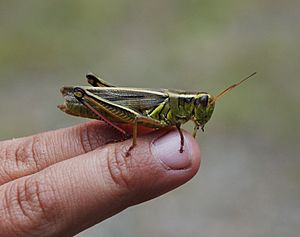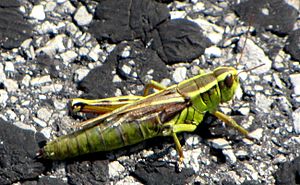Two-striped grasshopper facts for kids
Quick facts for kids Two-striped grasshopper |
|
|---|---|
 |
|
| Female M. bivittatus | |
| Scientific classification | |
| Subspecies | |
|
The Melanoplus bivittatus, also known as the two-striped grasshopper, is a common type of grasshopper. It lives in North America, especially in the wide-open prairies and farmlands of Canada. This grasshopper is a poikilothermic animal. This means its body temperature changes to match the temperature of its surroundings.
Contents
What Does It Look Like?
This grasshopper is quite large. It can grow to be about 30 to 55 millimeters long. You can easily spot it by the two light yellow stripes. These stripes run along the top of its body. They go from above its eyes all the way to the tips of its back wings. Because of these stripes, it is sometimes called the yellow-striped grasshopper.
Its body is usually yellowish-green. This color comes from special proteins and pigments. Like most grasshoppers, it has big back legs for jumping. It also has two pairs of wings. One set of wings overlaps the other.
Life Cycle
Two-striped grasshoppers lay their eggs in the soil during winter. These eggs usually start to hatch in late April or early May. If conditions are just right, like around 25 degrees Celsius and very moist, the eggs will grow for about 21 days.
Sometimes, the eggs will pause their growth. This pause is called diapause. It happens when conditions are not perfect for growing. The eggs will wait until spring when it gets warm enough. Then, they will start developing again. Once hatching begins, most eggs hatch between the 10th and 13th day. By the time a young grasshopper is fully grown, it will have gone through five stages of growth, called instars.
Mating and Reproduction
Two-striped grasshoppers can spend many hours mating. Some pairs stay together for up to 10 hours. Their mating habits are similar to red-legged grasshoppers. During mating, the male gives the female a special package. This package is called a spermatophore. It contains both sperm and nutrients.
Males provide these packages throughout the mating period. Longer mating times help transfer more genes. They also allow for more sperm and nutrients to be passed on. After mating, females can wait up to 21 days before mating again. Females often accept males because they benefit from the protein and nutrients in the spermatophore.
What Do They Eat?
Melanoplus bivittatus grasshoppers are polyphagous. This means they can eat many different kinds of food. Their main diet includes plants like forbs and lentil crops. You often see them eating various crops on farms across North America.
If there isn't enough food, these grasshoppers might even eat each other. This is called cannibalism. When the weather is colder, below 25 degrees Celsius, they usually stop eating. This is because their bodies slow down. These grasshoppers need certain fats in their diet, like linoleic acid or unsaturated fatty acids. These fats help keep their wings from getting crumpled.
Why Are They Pests?
Grasshoppers, including the two-striped grasshopper, are known as pests in farming areas. Some types of grasshoppers can cause a lot of damage to crops. This can be a big problem for farmers.
Melanoplus bivittatus can harm crops throughout their entire life. They often eat the parts of plants that help them reproduce. This includes the sepals, flowers, and young or mature pods. When these parts are eaten, it makes it very hard for the plants to grow back or make new seeds.


